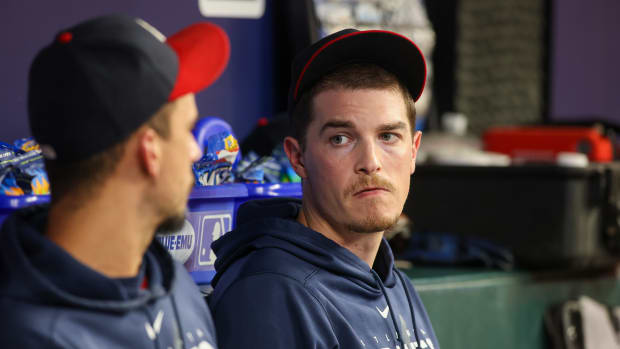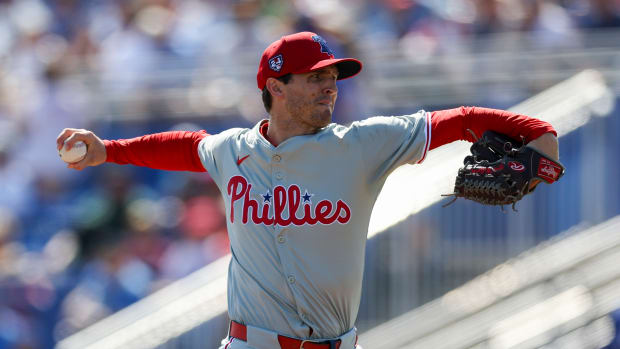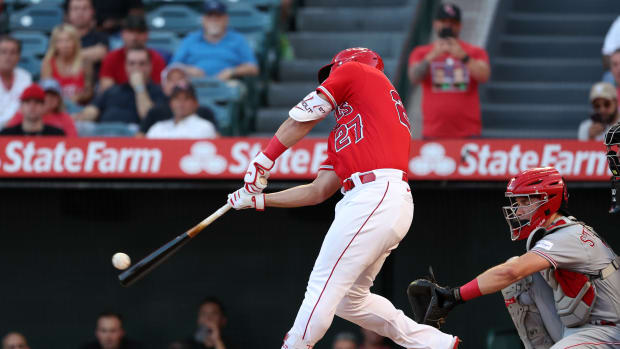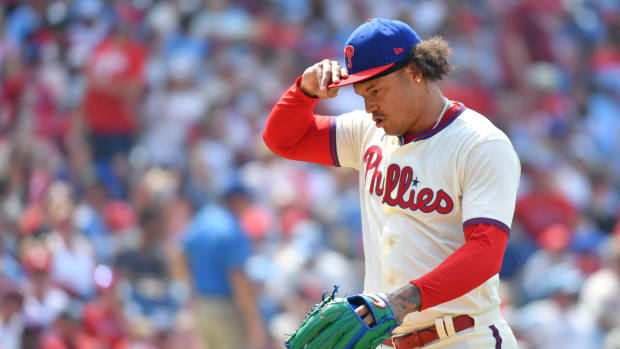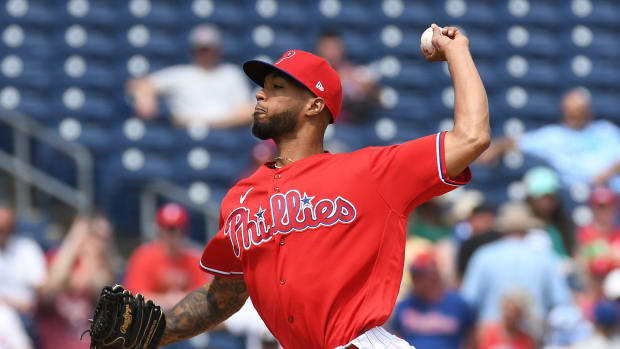How the Phillies Will Win the 2022 World Series
Citizens Bank Park is alive with the noise and thunder of 45,000 screaming fans. Rally towels waive as Seranthony Domínguez checks the runner on first. He pauses, taking a deep breath, calming himself for the most important pitch of his life.
Dominguez throws his slider for a swing and a miss. Fans across the Delaware Valley erupt in a cacophonous roar. The Philadelphia Phillies have won the 2022 World Series.
J.T. Realmuto, the Phillies' ever-steady catcher, tosses his mask and runs to tackle his closer. Rhys Hoskins, clubhouse leader, joins the euphoric mob on the mound. Bryce Harper sprints towards the pileup from right field, and in less than an hour, he’ll be crowned World Series MVP.
Soon the celebration includes Rookie of the Year Bryson Stott, Cy Young winner Zack Wheeler and runner-up Ranger Suarez. Silver Slugger Nick Castellanos holds back tears while Gold Glover Jean Segura waits to congratulate his countryman Domínguez.
Nine months prior, the Phillies had stumbled out of the starting block in April. Plagued by injury to their rotation and bullpen, they’d struggled to crack .500 during the early months of the season.
Aaron Nola, one of only two healthy starters to begin the season, starts off slowly. The long ball, which had haunted him in 2021, continues to be a factor in 2022. Through the end of April, Nola has an ERA nearing 5.00. At the very least, he’s gone deep into ball games, spelling an exhausted bullpen.
The Phillies other fully healthy starter to begin the season is Kyle Gibson. Like Nola, his ERA is in the mid-4.00’s. But Gibson isn’t expected to revolutionize the Phillies rotation. He's meant to complement 2021 Cy Young runner-up Wheeler.
Wheeler starts the season off effective but slow, literally. His fastball velocity never touches 100mph until June, a peak it reached regularly in 2021. He begins the season as the Phillies fifth starter, making his debut April 18 in Colorado against the Rockies. But not until late-May does Wheeler build up to a full starter’s workload.
Zach Eflin and Ranger Suárez both face similar concerns. But unlike Wheeler, they’re both up to full strength by the end of April. Meanwhile, Bailey Falter is extremely effective as a depth starter and follower. By mid-season, he already has 60 innings under his belt, primarily out of the bullpen. His ERA is below 3.00 and the advanced stats back up his effectiveness.
Like the starting rotation, the bullpen seems incomplete, but there’s no extra help coming for them besides league-average relievers Sam Coonrod and Jose Alvarado. Corey Knebel establishes himself as a solid closer, but the jewel of the Phillies’ pen is Domínguez.
He’s reinvented himself as a fastball/slider specialist. Even in 2018, Domínguez was never this effective. He conjures images and comparisons to the Cleveland Guardians’ Andrew Miller in 2016 for his multi-inning work out of a beleaguered bullpen. His ERA barely crosses the 2.00 threshold the entire season.
His excellence isn’t enough to make up for the depth pieces and Quadruple-A relievers that litter the ‘pen. Nick Nelson, Damon Jones and Ryan Sherriff are all almost unplayable even in mop-up duties.
Nevertheless, the Phillies continue to out-hit their pitching struggles.
Though Kyle Schwarber takes some time to get used to his new setting in Philadelphia, his OBP remains high enough to warrant hitting in the leadoff spot. Hoskins and Nick Castellanos mash home runs with regularity while Bryce Harper continues the tear with which he ended the 2021 season.
The top four hitters in the Phillies lineup are unrivaled throughout baseball. The bottom half of the order, composed of Realmuto, Segura, Didi Gregorius, Stott and Matt Vierling maintain respectable slashlines.
Even the defense remains composed. Though many analysts picked the Phillies defense to be a hindrance, it hasn’t made the pitching look any worse, and remains an eye sore as opposed to a true liability.
Segura plays Gold Glove defense at second base like he has since 2020. Gregorius is a below-average shortstop, but now that he’s healthy, his defense is acceptable. Stott plays league-average third base, the same is true with Vierling in center field. Even Harper returns to the defensive form he’d shown with the Phillies in 2019, showing off his arm and some speed in the outfield.
Due to the pitching, the Phillies are 25-23 by the end of May. The lineup is all that fans had hoped, but the Phillies haven’t had consistently good appearances from any of their starters.
By June, Wheeler is back to full strength, so are Suárez and Eflin. Now things really kick into gear.
On June 12, the Phillies sweep the Arizona Diamondbacks at home, they follow that series with a sweep of the Miami Marlins, then they sweep a four game series against the Washington Nationals.
The club is rounding into form as Wheeler tosses a complete game shutout to cap the win streak at 11 in Texas on June 21. The Phillies lose that series to the Rangers, but in June and July combined they end up dropping only 12 games.
64-35 is the Phillies' record headed into August. They sit comfortably atop the National League East, 4.5 games above the Mets and 7.5 games above the Braves.
But things have begun to slow down by late-July. Eflin is troubled by the knee issues which have plagued his entire career. He’s shut down through mid-September. The Phillies attempt to bring Falter back as a starter, but his effectiveness out of the bullpen doesn’t translate to the rotation.
With just a week to go before the trade deadline, Phillies President Dave Dombrowski acquires a package deal from the Los Angeles Angels, headlined by Noah Syndergaard and Alec Bohm and Andrew Painter. Former fan-favorite Archie Bradley joins the Phillies from the Angels as well.
By August, Wheeler and Suárez have now established themselves as one of MLB’s top one-two punches, rivaling even Jacob deGrom and Max Scherzer. Even Nola has slowly rounded into form, posting and ERA below 3.00 since the Phillies 11-game win streak began in June.
Tragedy strikes in the first week of August.
Hoskins strains his oblique running to first base and is sidelined for the rest of the regular season. Schwarber is forced to fill in at first base, but his defensive shortcomings are easily apparent.
Even Schwarber’s offense starts to slip after the move. Bohm is no longer an option there as he platoons with Jared Walsh at first base in Los Angeles. The Phillies are forced to go with Schwarber at first for the rest of the season.
Soon the entire lineup begins to falter. Castellanos is moved from DH to left field and his defensive liabilities are unavoidable. Johan Camargo does a solid job at filling in on the margins, but he sees more playing time now that Hoskins is injured. Gregorius goes into a slump in mid-August too.
The starting rotation keeps the Phillies from faltering too much however. The combo of Wheeler, Suárez, Syndergaard, Nola and Gibson is one of baseballs’ best. Combined, their ERA is below 3.75.
Archie Bradley helps whip the bullpen into shape as well, bringing back life into a now dour clubhouse. At the back end, Knebel, Dominguez, Bradley and Brogdon do a solid job holding leads.
By mid-September, Eflin returns, forcing Gibson to a bullpen role and further strengthening late-game performances.
With five games left in the season, the Phillies clinch the NL East in Washington. The stadium is almost half-full with Phillies fans as Knebel’s trademark 12-6 curveball forces a weak ground ball from Josh Bell.
The Phillies have won 97 games. The celebration on the mound is somewhat muted, they yearn for more than a division title, they want a World Series title.
With 99 wins, the Phillies take the number-two seed in the National League, getting a bye past the Wild Card series.
They face the Milwaukee Brewers in the Division Series, but are silenced in Game 1 at Citizens Bank Park by Corbin Burnes. Game 2 features a matchup between Suárez and Brandon Woodruff. Suárez goes the distance, allowing just five Brewer base runners in a shutout effort, the Phillies take Game 2 and the series moves to Milwaukee.
At American Family Field in Milwaukee, Phillies pitchers Aaron Nola and Noah Syndergaard dispatch Freddy Peralta and Adrian Houser easily, outscoring the Brewers 12-5 over the two games. Schwarber hits two home runs in game four while Segura has a multitude of opportunities to show off his defense at second base.
The Phillies await with bated breath to see who their next opponent will be. A day later, the New York Mets lose the National League’s other division series in five games. The 104-win Los Angeles Dodgers will be the Phillies' opponent for the NLCS.
Surprise relief comes for the Phillies during the inter-series break in the form of Rhys Hoskins, he’s back a week early from injury to DH the upcoming series.
The Game 1 matchup is between Wheeler and Dodgers’ midseason acquisition Zack Grienke in Los Angeles. Just days before his 39th birthday, Grienke is at the top of his game, buckling Phillie hitters with a change-up/curveball mix and allowing just two runs on a sac fly and RBI groundout.
Wheeler is even better, allowing one run over eight innings. Knebel comes in to close the game and the Phillies take a 1-0 series lead.
Suárez falters in Game 2 against Clayton Kershaw as does Nola in Game 3 against Walker Buehler. The situation is dire, with four games left against MLB’s best team, the Phillies must win three. Syndergaard pitches Game 4 against Julio Urías and is helped by back-to-back homers in the first and seventh innings from Hoskins and Harper. The Phillies take Game 4, 7-3.
The following day, Wheeler outduels Grienke for a second time, flipping the narrative and moving the series back to Los Angeles with just one Phillies win needed to clinch a pennant.
But Dodger bats show up in Game 6, knocking Suárez out of the game in the second inning and putting a 14-4 drubbing on the Phillies to force a Game 7.
The Phillies play their first Game 7 in team history on October 23. Nola will take the hill, and every pitcher but Suárez is available out of the bullpen.
Justin Turner hits a two-run home run in the first inning and the Phillies must now come from behind to stay alive. But bats are silenced by Buehler through five innings for the Phillies, while Nola keeps the Dodgers scoreless after the first inning debacle.
In the eighth inning, the Phillies begin to rally. Hoskins walks, then Harper singles and so does Castellanos to load the bases. But Realmuto strikes out. He’s followed by Bryson Stott who grounds out sharply to second baseman Chris Taylor, he throws home for one out, but catcher Will Smith is unable to turn the double-play at first.
Two outs.
Still mired in a slump, Gregorius strides to the plate. Since the beginning of September, his batting average has been below the Mendoza line. Though he was a fearsome hitter for much of the year, his late-season form has caused a drop in the batting order.
Didi takes strike one.
The Fox Sports camera pans to the Phillies dugout. Joe Girardi stands motionless near the dugout steps, his hands in the pocket of his hoodie. Kyle Schwarber is on the railing with outfield teammate Matt Vierling. Jean Segura chews his gum vigorously watching on in nervous elation.
Didi swings at strike two, a ball in the dirt.
The Dodgers Stadium crowd rises to its feet, the collective roar of 57,000 fans is deafening. Dodger pitcher David Price comes set with the pitch.
14 years ago today, Price was a 23-year-old rookie pitching against the Phillies in Game 2 of the 2008 World Series. In the years since, the Phillies have risen and fallen and so has Price, from a hotshot reliever, to a Cy Young winner and now back to a reliever on a championship contender.
Price throws a slider, it’s a perfect pitch to a left-handed hitter like Gregorius, low and on the outside corner, it just catches the edge of the strike zone. But Gregorius does something he’s never done in his life.
He hammers the ball the other way to left field. It’s a low-liner streaking towards a rendezvous with destiny that’s going to be out of the reach of left fielder A.J. Pollock. He watches helplessly as the ball bounces on the top of the wall and out for one of the shortest home runs in stadium history.
A vacuous silence fills the cool night air as Gregorius rounds bases. Phillies leap out of the dugout in frenzied celebration, swarming their shortstop.
Dominguez completes the final six outs of the game and the Phillies have won the pennant.
The celebration in the clubhouse goes well into the morning and the plane ride. But the team doesn’t fly home. They fly to Tampa for a meeting with the Rays.
Momentum is on the Phillies' side following the NLCS, they take Games 1, 2 and 3, benefitting from the offense of Nick Castellanos and Bryce Harper, and pitching performances from Syndergaard, Wheeler and Suarez.
Nola is again on the mound for a clinching game. After a tumultuous NLCS, the Phillies play inspired baseball. They take a 6-3 score into the ninth inning for Dominguez to close out the game.
Two days later, the parade down Broad Street begins. Nearly two million line the streets in delirious joy at the team that brought a championship home to Philadelphia.
More From SI's Inside The Phillies:
- How Mike Trout Will Join the Phillies
- Phillies Top-10 Prospects Heading Into the 2022 MLB Season
- 18-Year-Old Phillies Prospect is Making History
- How did Philadelphia end up with Citizens Bank Park?
- How the Phillie Phanatic Came to be America's Favorite Sports Mascot
- This Unlikely Draft Pick Could be the Final Piece in the Phillies Next Blockbuster Trade
- Phillies 2022 Opening Day Roster Prediction
- Picking the Phillies' All-Time Single Season Lineup
- Could Alec Bohm be Dealt Before the Season Begins?
- Castellanos Shows He's Ready to Play in Philadelphia
Make sure to follow Inside the Phillies on Facebook and Twitter!

